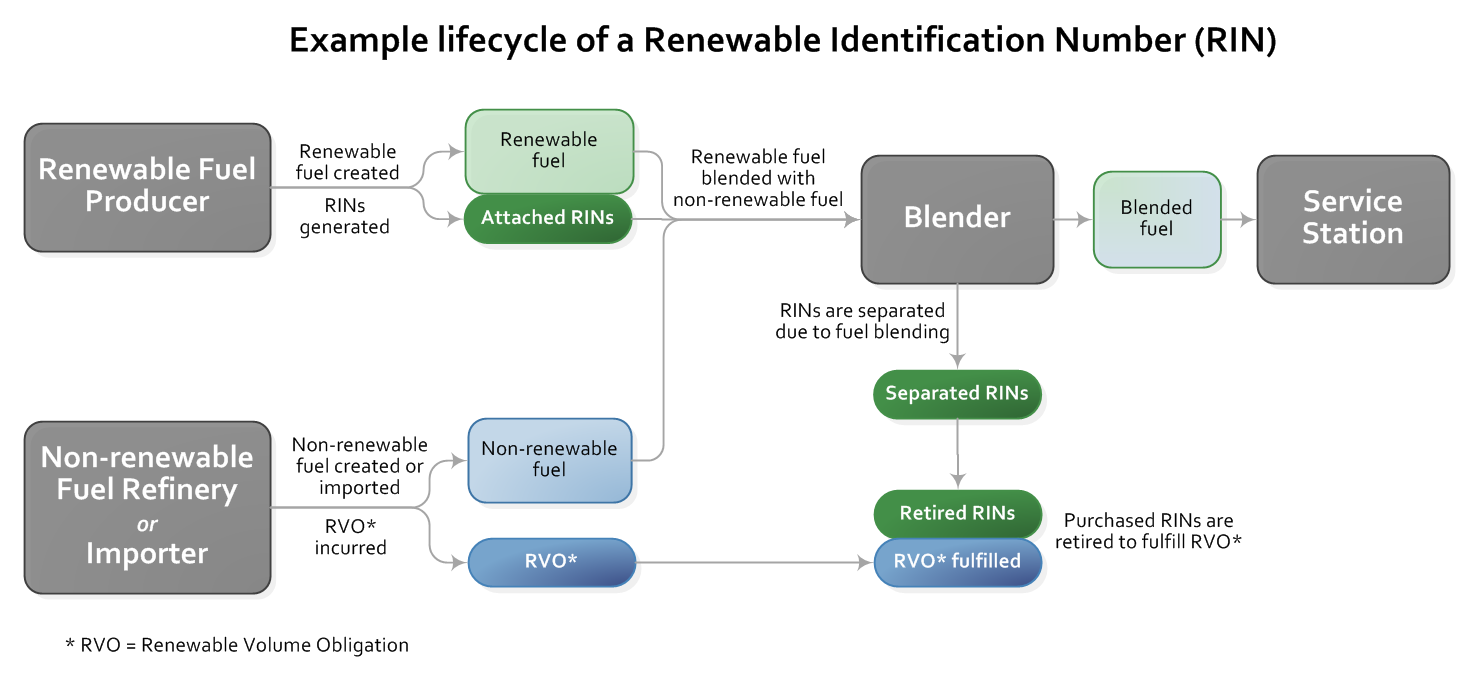
What Is It – Renewable Identification Numbers
If your fleet is exploring ways to reduce its carbon footprint, you’re likely considering renewable fuels as one avenue to carbon reduction. You may have hit a roadblock in your research though, since renewable markets can be quite complicated as you dig under the surface. As we talk more and more about renewable fuel and sustainability, it is important for us to understand the terminology used in association with these topics. Today, we are going to be diving into Renewable Identification Numbers (RINS), what they are used for, and why we need them.
What are Renewable Identification Numbers (RINS)?
“RINs” is short-hand for Renewable Identification Numbers, which are serial numbers used in the United States to track the production, use, and trading of renewable fuels such as ethanol and biodiesel.
RINs help ensure that enough renewable fuels are blended with petroleum-based fuels each year. Each RIN represents one gallon of renewable fuel and is assigned to the producer of the fuel. RINs can be traded on a market and are used to demonstrate compliance with renewable fuel standards. The U.S. Environmental Protection Agency (EPA) is responsible for overseeing and enforcing blending mandates and developing regulations for RINs.
Why do we need RINs?
RINs are a key component of the Renewable Fuel Standard (RFS) program in the United States, which serves to reduce greenhouse gas (GHG) emissions and promote energy independence. Under the RFS program, “obligated parties,” fuel producers such as refiners and importers of gasoline and diesel, are required to blend a certain amount of renewable fuels into their products each year. They can also comply with the standard by purchasing RINs from producers of renewable fuels.
Each gallon of renewable fuel produced is assigned a unique RIN. A renewable fuel producer selling 10,000 gallons of ethanol would transfer 10,000 RINs along with the fuel to the buyer. As the renewable fuel is physically blended into conventional fuel, the corresponding RIN is separated and can be traded independently. The RINs are retired by the EPA to ensure that the renewable fuel is properly accounted for under the RFS program.
Here’s a simplified example: Let’s say the EPA wants 10 billion gallons of renewable fuels to be used during the year. They’ll require that “obligated parties” (those producing or importing petroleum products) retire 10 billion RINs. Renewable producers create 10 billion gallons of renewable fuel, and as those gallons are blended with petroleum products, the RINs are freed up. A refiner, who produced the petroleum product, will either do the blending themselves to collect the RIN or they’ll buy them on the open market to retire them. If renewable producers only produce 9 billion gallons, refiners will have to scramble to secure RINs, driving up the cost and therefore making it more lucrative for renewable producers to ramp up production.
Of course, RINs are much more complex than that example – different products may have different RIN values, and the EPA may require more of one type of product versus another. But the example is a helpful guide to understanding the principles behind the RINs market.
When did RINs originate?
The first RINs were generated in 2007 under the Energy Independence and Security Act, and the program has continued to evolve since then. The EPA oversees the implementation of the RFS program, including the generation, trading, and retirement of RINs. The program has had a significant impact on the renewable fuel industry in the United States and has helped to increase the use of biofuels in the transportation sector.
How are RINs generated?
To generate RINs, renewable fuel producers or importers must first register with the EPA and receive a unique company and facility identifier. Then, when they produce or import renewable fuel, they generate RINs based on the volume of renewable fuel produced or imported. The RINs are assigned a unique identification number and are tracked through the RFS program from production to end use.
Once the renewable fuel is blended with conventional fuel, the RINs can be separated and traded to obligated parties to demonstrate compliance with the RFS program. RINs can also be traded on a secondary market to other market participants, such as speculators or traders.
How do oil refiners use RINs?
Oil refiners in the United States are required to blend a certain amount of renewable fuels into their products. If refiners are unable to meet their blending obligations through physical blending, they can use RINs as an alternative compliance mechanism.
The use of RINs as an alternative compliance mechanism can provide flexibility for oil refiners to meet their obligations under the RFS program. However, the cost and availability of RINs can vary, and the use of RINs has been a subject of debate among stakeholders in the biofuels and petroleum industries. Some oil companies have sought exemptions from retiring RINs on the basis of economic hardship.
Are Renewable Identification Numbers used in Canada?
RINs are not used in Canada as they are a unique feature of RFS program in the United States and are used to track the production, use, and trading of renewable fuels. Canada has its own renewable fuel standard, the Renewable Fuels Regulations, which was established in 2010. Under this program, fuel producers and importers in Canada are required to meet renewable fuel content requirements. However, the mechanism for tracking compliance with these requirements is different from the RFS program in the United States and does not involve the use of RINs.
Instead, Canadian renewable fuel producers generate compliance units, which are similar in some respects to RINs, but have different tracking and trading mechanisms. Compliance units are issued for each liter of renewable fuel produced or imported and can be traded between producers, importers, and blenders to meet the renewable fuel content requirements.
Do I need to understand RINs to buy biofuels?
The short answer is no – you can start buying biofuels today without an advanced background in Renewable Identification Numbers. In fact, it’s very likely you’re already buying some biofuels. Diesel fuel within the US may have up to 5% biodiesel while still being called ULSD. If you buy gasoline for your car, you’re putting 10% ethanol in your tank. So your fleet can convert to biofuels today without having to understand all the background of the RFS, RVOs, and RINs.
That said, a good understanding of Renewable Identification Numbers is helpful in understanding the economics of renewable fuels. Higher RINs prices should incentivize more renewable fuel production, in turn reducing the cost of biofuels. The flip side is also true. If you’re already committed to purchasing renewable fuels for your organization’s sustainability goals, then tracking RINs markets is a good indicator of future supply availability of RINs.
This article is part of Daily Market News & Insights
MARKET CONDITION REPORT - DISCLAIMER
The information contained herein is derived from sources believed to be reliable; however, this information is not guaranteed as to its accuracy or completeness. Furthermore, no responsibility is assumed for use of this material and no express or implied warranties or guarantees are made. This material and any view or comment expressed herein are provided for informational purposes only and should not be construed in any way as an inducement or recommendation to buy or sell products, commodity futures or options contracts.







